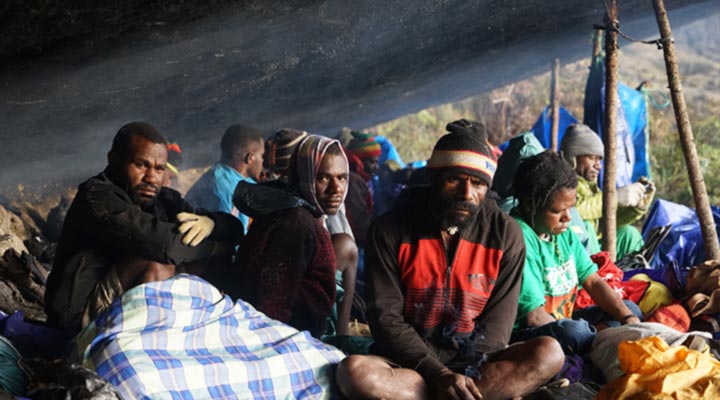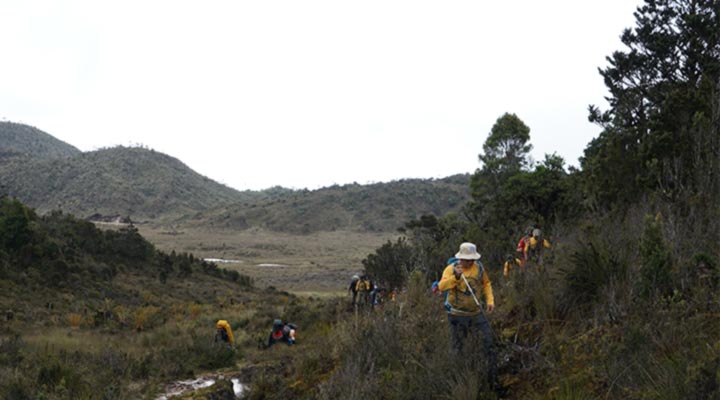MOUNT TRIKORA - 4,730 M
Located on the eastern side of the Sudirman Mountain Range (Nassau Mountain Range) or parallel to the Carstensz Pyramid, Trikora peak is the first to lose his snow than some other mountains in its ranks. However, Trikora never loses its appeal. In the context of the Second Seven Summits, some climbers are still considering Trikora as the second highest peak after Carstensz (4,884m) than Puncak Mandala (4,640m) located in Jayawijaya Mountains (Orange Mountain Range). Besides all of that reason, the ease of access makes Trikora become a favored among its nearby neighbors.
2023 Schedule
- March 23 - April 9
OVERVIEW
The peak previously named Wilhelmina (named after the Dutch Queen Wilhelmina), Trikora became a symbol of the exploration triumph when the HA Lorentz’s expedition became the first team that reached the equator snow in New Guinea at an altitude of 4,460m in 1909, when there was no attempt to reach its peak. Only after 1913, Franssen Herderschee, Hubrecht, and Versteeg managed to reach the peak of Trikora / Wilhelmina (4,730m) for the first time. And since 1936, the snow on Trikora peak shrinking drastically. Located on the eastern side of the Sudirman Mountain Range (Nassau Mountain Range) or parallel to the Carstensz Pyramid, Trikora peak is the first to lose his snow than some other mountains in its ranks. However, Trikora never loses its appeal. In the context of the Second Seven Summits, some climbers are still considering Trikora as the second highest peak after Carstensz (4,884m) than Puncak Mandala (4,640m) located in Jayawijaya Mountains (Orange Mountain Range). Besides all of that reason, the ease of access makes Trikora become a favored among its nearby neighbors. In term of access route, Trikora peak is consider to be the easiest compared to the Carstensz (4,884m), Idenburg (4,730m), and Mandala (4,640 m). Now we were able to use 4WD vehicles from Wamena, a city located in Baliem Valley, to the base camp at Lake Habbema. More or less, after 3-4 days of climbing attempt, we can reach the summit of Trikora. Trikora Peak technically easier to climb than Carstensz, but still need a rope as a safety line. Behind the shadow of Trikora peak, lies a place that is no less beautiful, Baliem Valley. The only grand valley that divides the backbone of New Guinea Island. Baliem Valley Trip is a journey that took us back to the Stone Age in which the inhabitants of this valley, the Dani tribe still maintaining the conditions and the way of life back in time of their ancestors. Therefore, many local and foreign tourists visit the Baliem valley and usually on July, Baliem Festival was held. There we can see a variety of traditional Dani tribe.
ITINERARY
- DAY 1
- Meeting Point at Bali Arrive in Bali. Upon arrival, our guide will pick you up at the airport and transfer to hotel. Rest.
- DAY 2
- Bali-Jayapura This morning, our guide will give you some orientation about the expedition and gear check. Our flight today will be at midnight, so you have time to relax or explore Bali. Welcome dinner from us and after that we go to airport and fly to Jayapura.
- DAY 3
- Jayapura-Wamena Arrive in Jayapura in the morning. We then continue our flight with different airline to Wamena. Transfer to hotel, final packing, and rest.
- DAY 4
- Wamena-Habema Lake–Wamera Shelter In the morning, we will go to Habema Lake (3,300m) by 4WD vehicle for 2 hours. Then continue trekking to Camp 1. We will walk through a meadow and rocky ridges until the first camp, Wamera Shelter. It will be a 5 hours trek. We will stay overnight here.
- DAY 5
- Wamera Shelter–Rock Shelter (3,800m) Early in the morning, we start trekking to the second camp. It will be 7-8 hours trek today, gaining more altitude. The second camp is a rock shelter at the foot of Trikora peak (4.730 masl). The Rock Shelter will protect us against the wind and rain. Stay overnight here.
- DAY 6
- Rock Shelter–Summit Camp (4,300m Another 3-4 hours trek to the Summit Camp, just below the summit ridge with a 500 m altitude gained. The porter can go with us to the Summit Camp but go back to the Rock Shelter for overnight.
- DAY 7
- Acclimatization Rest to maximize the acclimatization process
- DAY 8
- Summit Camp–Summit–Summit Camp Summit Day, it will be a long and tough day. We start at 3 or 4 o’clock in the morning. We follow the valley for an hour, then 30m scrambling to get to the ridge. This part to the summit will be technical that require rock climbing, scrambling, and descending. Four hours of obstacle trek and we reach the summit. After summit, we will go back to Summit camp, it will take 3-5 hours to descend.
- DAY 9
- Summit Camp–Wamera Camp It’s a long way back to Wamera Camp, we start after porters come and pick up our luggage in the morning. Trekking at the same route to Wamera will takes 7-9 hours. Stay overnight at Wamera Camp.
- DAY 10
- Wamera Camp-Habema Lake–Wamena Trekking around 2-3 hours to the road, we will be picked up by the vehicle and go back to Wamena. Stay overnight in Wamena.
- DAY 11
- Wamena-Jayapura–Bali Take the morning flight back to Jayapura. Transit for a while and then continue the flight to Bali. Spent one night in Bali with celebration Dinner.
- DAY 12
- Bali We will drop to the airport. End of expeditions.
INCLUDE
- Airport transfer at Bali
- 2 nights hotel (twin share) in Bali
- Domestic flight Bali-Wamena round trip
- 2 nights hotel (twin share) in Wamena
- 4WD vehicle Wamena-Habema Lake round trip
- Indonesia Expeditions Guide
- Cook & Porters
- Travel permit from Indonesian Police Department
- Climbing permit
- Meals in Wamena
- Meals on the mountain
- Sleeping tents, Dining tent, Tables & Chairs
- Fuel, cooking stove, and cutlery
- Ropes and group climbing gears
- Satphone
EXCLUDE
- International flights
- Indonesian Visa
- Meals in Bali
- Excess baggage for domestic flights (Baggage allowance 20 kg)
- Personal clothing and climbing equipment
- Personal travel insurance
- Personal natural expense (laundry, telephone, etc)
- Gratuities
PREPARATION
Trikora is not as technical as Carstensz. Though, the last part to the summit require some rock climbing. At least you need to know quite well about rope skills. Practice using ascender and descender several times before going on this expedition. Even if you already used to, it’s always good to refresh your skills. Rock climbing training also needed. Aim to climb routes at 5.8-5.9 grade, and try using your mountaineering boots. You can do these training at the rock-climbing gym in your hometown. For physical conditioning, you can do running two to three times a week for 45 minutes to an hour per session. Running on a route that have elevation gain will be a lot better, or use treadmill if there’s no such terrain in your hometown. You can change one of your running sessions in a week with cycling or swimming and especially you need to do also stair climbing with at least 10kg pack. It will be a good cross training. Besides that, muscle training is advisable. Strengthen your upper and lower body muscle, as well core muscle. You can do it at the gym or do your own set of push-ups, sit-ups, pull-ups, plank, etc. Good physical condition can help with the acclimatization also. Training 6 month prior to the expedition will be fantastic, or at least spare 2-3 month before for your training. Having good preparation will be the key for success, and we believe you can enjoy your expedition more.
GEAR LIST
| No | Name | Amt |
|---|---|---|
| 1 | Alpine climbing harness | 1 |
| 2 | Locking carabiners | 3 |
| 3 | Snap carabiners | 2 |
| 4 | Ascender | 1 |
| 5 | 1,5 meters of 7mm Prusik/Accessory cord | 2 |
| 6 | Figure of 8 (Rappel/belay device) | 1 |
| 7 | Climbing helmet | 1 |
| 8 | Gaiters | 1 pair |
| 9 | Wool or Synthetic socks | 3 pair |
| 10 | Liner socks | 2 pair |
| 11 | Trekking/Mountaineering Boots | 1 pair |
| 12 | Rubber boots | 1 pair |
| 13 | Trekking pole | 1 pair |
| 14 | Midweight Baselayer Top (amount based on preferences) | 3 |
| 15 | Midweight Baselayer Bottom (amount based on preferences) | 2 |
| 16 | Trekking/Soft Shell pants | 2 |
| 17 | Soft Shell Jacket/puffy | 1 |
| 18 | Rain jacket & pants | 1 |
| 19 | Insulated jacket/Lightweight down jacket | 1 |
| 20 | Insulated synthetic pants | 1 |
| 21 | Baseball cap | 1 |
| 22 | Beanie | 1 |
| 23 | Buff (amount based on preferences) | 2 |
| 24 | Sunglasses | 1 |
| 25 | Lightweight synthetic liner gloves | 1 pair |
| 26 | Leather garden gloves or rappel gloves (waterproof better) | 1 pair |
| 27 | 30L Backpack | 1 |
| 28 | Sleeping bag at least -10°C | 1 |
| 29 | Self-Inflating pad (optional) | 1 |
| 30 | Closed-cell foam pad | 1 |
| 31 | Headlamp with spare batteries | 1 |
| 32 | Sunscreen, SPF 40 or better | 1 |
| 33 | Lip screen, SPF 30 | 1 |
| 34 | 1 Litre water bottle or water bladder | 2 |
| 35 | Toiletry bag | 1 |
| 36 | Large Duffel Bag | 1 |
| 37 | First aid kit and special medications (if any) | 1 |
| 38 | Camera | 1 |










